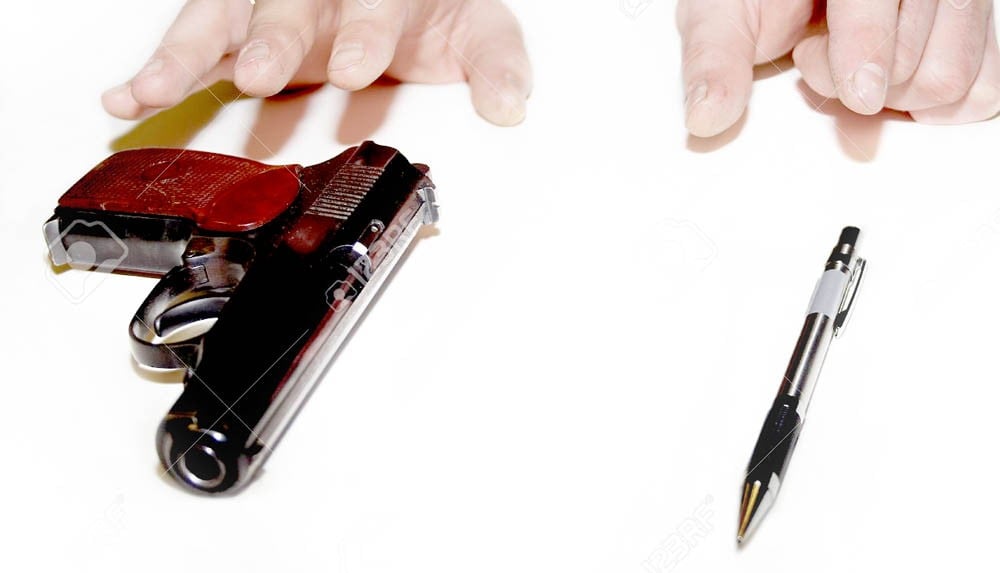

I have recently been asked to comment on the ‘Use of Pen Instead Of Weapon’ by a well-reputed university of Lahore. It offers me an opportunity to reflect on quite an antipodal relationship between the pen and the weapon.
In this equation, the pen acts as an instrument of peaceful and well-informed negotiation, whereas the weapon (read sword) is a source of obliteration of its Other. It seems rhetorical to point out that the pen is dependent on certain language to carry out an intended act but the weapon merely enacts the will of the executioner. Thus the general sense drawn from the above adage privileges the pen over weapon as a source of disseminating peace and equanimity in days of turbulence and disquiet as we witness in this day and age.
The ‘liberal’ and the ‘enlightened’ ascribe that magnanimity to the use of pen. The weapon, on the other hand, represents subversion aiming to destroy peace. Probably the same was depicted through the statue of Sir John Lawrence, the first Lieutenant Governor of the Punjab and later the Governor General of India (1864-1869), with him holding a pen in one hand and a sword (weapon) in the other, one placed outside the Lahore High Court on The Mall.
The statue was sculpted by Sir Joseph Boehme and was inaugurated in 1887, with "Will you be governed by the pen or sword?" inscribed at its base.
Pen in that particular case symbolised an exhortation by the ruler to the ruled to observe peace (read acquiescence) and be ‘good’ subjects; in lieu, they would be entitled to lawful and just treatment. Recalcitrant and refractory would be dealt with the sword. But poor Punjabis were oppressed both by the use of pen and sword. In the instance of John Lawrence, pen and sword were projected as binary opposites.
But that is not always the case.
The political stance of Sir Syed Ahmed Khan can also be mentioned here to make a case for the pen. He unequivocally lent support to the British Raj and denounced fighting against them. Muhammad Ali Jinnah’s wholehearted espousal of constitutionalism also points towards the same proclivity, that of prioritising pen over weapon.
The 20th century Muslim politics in India was far from violent and the sway of the pen seems to be completely established, though with a few odd exceptions, like the Khilafat Movement, Ahrar and Khaksars. Pakistan was the denouement of the endeavours of those, who preferred the peaceful political action instead of violent struggle.
However, the saga of later day Pakistan tells quite the opposite story. Weapons and violence has become our national signature.
But the fact that must not be obscured from our eyes is the coalescence between the pen and the sword. With the onset of modernity, textual tradition attained significance and pen pushers came to acquire a prominence that was hitherto unknown in the Indian subcontinent. Print culture particularly in the vernacular, as Francis Robinson notes in one of his important articles, was used by the ulema to their advantage. Religious texts and their exegetical interpretations were published in a large number and they enjoyed considerable circulation among the North Indian Muslim populace. Newspapers, tracts and pamphlets became the prime source(s) of communal or sectarian bickering.
So, from the last quarter of the 19th century onwards, pen was deployed as an effective weapon. Incrimination of the ‘adversary’, imagined or real through takfeeri fatwas or condemnatory statements, became very common. Social fissures in the plural society widened, leading to mutual animosity. Later texts produced by the pen triggered the usage of weapon.
Students of modern Indian history will be aware of various assassinations carried out because of reckless wielding of the pen. Such abominable writings, like Rangeela Rasul, were the outcome of an act performed through pen, which led to the assassination of its publisher, Ram Paul, by Ghazi Ilm Din from Lahore.
Among Muslims too the pen was used profusely to condemn other sectarian denominations.
After the partition, that trend became all pervasive. Anti-Shia texts proliferated in large numbers. Some writers like Abdul Shakoor Lakhnavi and Manzur Numani made their respective careers out of the anti-Shia diatribe that became their legacy.
Pen is also used to valorise those who wield weapons to the optimum effect. Nasim Hijazi is one such name whose pen has accorded a surreal romanticism to Muslim conquerors in history. He is one writer who has singlehandedly impacted the educated young minds in Pakistan through his fictionalised historical novels. His novels were promoted and patronised by Ziaul Haq in particular as Hijazi’s writings suited his jihadi campaign.
Later on jihad became a liet motif of several clerics who became scholars of Islam. The writings of these so-called scholars have inspired many to take up weapons and join the jihadi ranks. Masood Azhar and Sami-ul-Haq too have written extensively on the issue.
Considering that pen’s supremacy over weapon will bring about peace and prosperity is a wishful if not a misplaced dream. However, the question pertaining to the person wielding the pen or weapon is to my reckoning more seminal than the two inanimate objects. All educational institutions must work towards instilling a consciousness and sensitivity that prevents the people from misusing both pen and weapon.